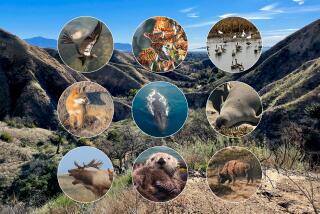Monarch
- Share via
[ DANAUS PLEXIPPUS ]
Here’s something to celebrate: The strongest migrant butterfly in the world is back. Flapping powerfully on slow wing beats, up to 5 million converge in fall on the California coast from across Western North America. Here they spend the winter in huge swarms, thousands upon thousands of monarchs cloaking entire trees in pumpkin-colored skeins.
On cold, wet days, the butterflies simply hang like passive leaves -- but when the sun comes out
they rise in shimmering clouds to find a quick
meal of nectar.
NATURAL HISTORY
In February, wintering monarchs frantically mate, then head northward. These adults soon lay eggs and die, but over the course of three to four quick generations, each group continues to push northward until many have reached Canada.
At summer’s end, new adults circle back
to California, where they rest over the winter
and save energy for breeding.
KEY CHARACTERISTICS
With up to a 4-inch wingspan, the monarch is one of the largest, and most beautiful, butterflies in North America. They use wintering sites around Pacific Grove on the Monterey Peninsula and at Natural Bridges State Beach near Santa Cruz year after year, but may be found at many other sites
as they move around seeking food and shelter.
More to Read
Sign up for The Wild
We’ll help you find the best places to hike, bike and run, as well as the perfect silent spots for meditation and yoga.
You may occasionally receive promotional content from the Los Angeles Times.






